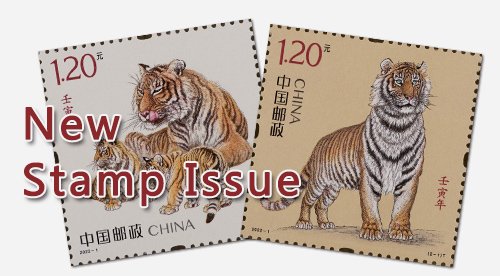 Postal Business: 8610 11185
Postal Business: 8610 11185Postal Savings: 8610 95580
Logistics and EMS: 8610 11183
China Post Life: 8610 4008909999
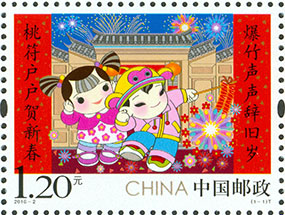 Giving New Year’s Greetings...2016-2
Giving New Year’s Greetings...2016-2As a continuation of the 2015 "Giving New Year's Greetings" issue, the stamp highlights the mood of the traditional Chinese festival. A boy named Huanhuan lights firecrackers and a girl named Xixi covers her ears, smiling. Auspicious couplets on either side illuminate the festive and peaceful atmosphere of the New Year celebration.
In accordance, China National Philatelic Corp. will issue a FDC and commemorative postmark.
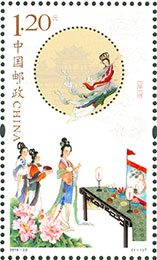 Full Moon in Mid-Autumn Festival...2016-23
Full Moon in Mid-Autumn Festival...2016-23Falling on the 15th day of the eighth month on the Chinese lunar calendar, the Mid-Autumn Festival gains its name for being in the middle of the three autumn months.
Second only to Spring Festival, it is a tradition with a long history. Originating from primitive worship of the moon, the term "Mid-Autumn Festival" appeared in the Tang Dynasty (618 A.D.—907 A.D.) and it became an important national holiday in Southern Song Dynasty (1127 A.D.-1279 A.D.).
People continue celebrating traditions of enjoying the glorious full moon, having moon cakes, watching the tides and reuniting with family members today.
The moon remains unchanged since ancient times as well as people’s veneration of traditions.
In accordance, China National Philatelic Corp. will issue a FDC and commemorative postmark.
 The Great Wall2016-22
The Great Wall2016-22As a great project in ancient China, the Great Wall embodies the nation's diligence and wisdom. It is the symbol of Chinese civilization and a treasure of human history and culture.
The Yan, Zhao, Qin and other vassal states in the Spring and Autumn Period (770 B.C.- 476 B.C.) began to construct the Great Wall in the northern farming pastoral zone in the 4th century B.C. It was constructed by dynasties and minority regimes in the central plains heartland.
The Great Wall was included into the World Heritage List for its unique historical, artistic and cultural value in 1987.
The present remains are the Ming Great Wall from the 14th century.
The Nine Figures display the natural and cultural landscape along the Great Wall of the Ming Dynasty (1368 A.D.-1644 A.D.), demonstrating the long history of the ruins. Starting from the east at Tiger Mountain of northeast China's Liaoning Province, the Great Wall continues through nine provinces, autonomous regions and municipalities and ends in the west at Jiayuguan Pass of northwest China's Gansu Province.
In accordance, China National Philatelic Corp. will issue a FDC and commemorative postmark.
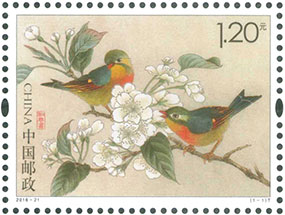 Leiothrix2016-21
Leiothrix2016-21Taxonomically belonging to passeriformes of aves, Leiothrix has two species: the red-billed leiothrix and silver-eared mesia.
The stamp shows the red-billed leiothrix, a famous decorative bird. With olive green upper feathers and the lower in orange, the birds' remarkable characteristic is a red beak and colorful wing spots.
Male and female birds are similar in morphology, showing an intimate relationship between them. Regarded as a symbol of devoted love, the Leiothrix is loved by people at home and abroad.
In accordance, China National Philatelic Corp. will issue a FDC and commemorative postmark.
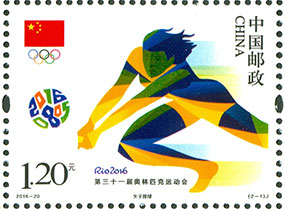 31st Olympic Games2016-20
31st Olympic Games2016-20The Opening Ceremony for the 31st Olympic Games was held at Maracana Stadium in Rio de Janerio, Brazil on August 5, the first time the Olympic Games were held in South America.
With the theme of "A New World", the Games has 28 big events and 306 small races, drawing more than 10,000 athletes from 200 countries and regions to take part. All events ended on August 21.
In accordance, China National Philatelic Corp. will issue a FDC and commemorative postmark.
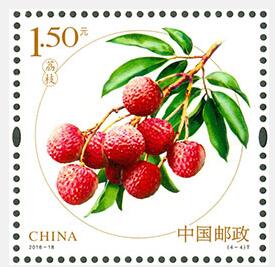 Fruits (Ⅱ)2016-18
Fruits (Ⅱ)2016-18The second issue of the Fruits stamp is a series that highlights the nutrition and bright colors of the fruits loved by people. They have been given auspicious meanings: Rich in iron and vitamin, apricots (Xing in Chinese), hints at happiness, good luck and prosperity. As one of the oldest cultivated plants, grapes can be eaten raw or made into wine. Hanging with fruit, it used to describe the harvest. As one of the main fruits in summer, watermelon is sweet and delicious. Its red color symbolizes a booming life and career. Litchi (Lizhi in Chinese), juicy and sweet, has homophonic symbolization with an auspicious meaning.
In accordance, China National Philatelic Corp. will issue a FDC and commemorative postmark.
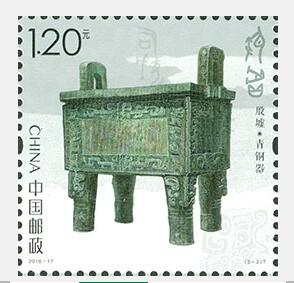 Yin Ruins2016-17
Yin Ruins2016-17Located on the banks of the Huan River in central China's Henan Province, the Yin Ruins, relics of the ancient capital of late Shang Dynasty (1600-1046BC), includes mausoleum ruins from the Shang Dynasty, and palace, temple and Huanbei Shang City ruins. Scientific excavation of the Yin Ruins began in 1928, unearthing a large number of construction relics and cultural heritage such as inscriptions on bones or tortoise shells, bronze and jade. They not only reflected the development level and productivity of the Shang Dynasty but also provided important basis for the study of rituals, lifestyle and civilization in that period.
The Yin Ruins were listed among national priority cultural relic protection sites in 1961, and a World Cultural Heritage site by UNESCO in 2006.
In accordance, China National Philatelic Corp. will issue a FDC and commemorative postmark.
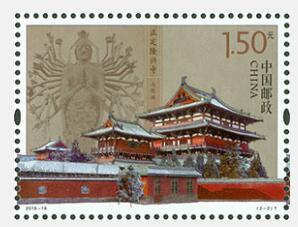 Longxing Temple at Zhengding...2016-16
Longxing Temple at Zhengding...2016-16Located in Zhengding County, north China's Hebei Province, Longxing Temple was built in the Sui Dynasty (581-618 AD), and is named for Longzang Temple that was expanded in the Northern Song or Earlier Song Dynasty (960 -1127 AD). Also enlarged and renovated in the Jin, Yuan, Ming and Qing dynasties, the temple retained the layout from the Northern Song Dynasty. The present 10 halls were scattered randomly along a north-south axis. It includes a bronze figure of a 42-armed Goddess of Mercy in the main hall of the Great Mercy Pavilion, a masterpiece of cast copper art in ancient times. The temple also contained more than 20 ancient inscriptions, among which the Longzang Temple Tablet from the Sui Dynasty was an important source for ancient calligraphy study.
Longxing Temple was listed among the initial national priority cultural relic protection sites in 1961.
In accordance, China National Philatelic Corp. will issue a FDC and commemorative postmark.
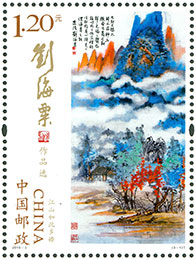 Selected Works of Liu Haisu...2016-3
Selected Works of Liu Haisu...2016-3Born in Changzhou city, e of East China's Jiangsu Province, Liu Haisu (1896-1994) was an outstanding art educator and master of art in 20th century as well as a pioneer of in China's new art campaign.
Devoted Devoting his life to art education and creation, he was well-versed in Chinese painting, traditional Chinese painting, calligraphy and art theory. Liu was good at landscapes, flowers and , birds, and beasts with using the ink spilt choi technique.
For the last few years of his life, Liu's painting, full of force and individual expression, was concerned with Huangshan, which gained him a widespread reputation both in China and abroad.
March 16, 2016 was the 120th anniversary of Liu Haisu's birth. The set of stamps capture “This Land so Rich in Beauty", "Ink Lotus" and Huangshan Waterfall".
The set of stamps were printed by three printers using three printing processes, a first in the history of Chinese stamps.
In accordance, China National Philatelic Corp will issue three FDC and three commemorative postmarks.
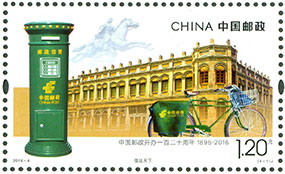 120th Anniversary of the Founding of Chi...2016-4
120th Anniversary of the Founding of Chi...2016-4March 20, 2016 is the 120th anniversary of the founding of China Post, a continuation of the National Post begun during the late Qing Dynasty (1644-1911), which was established on March 20, 1896, marking the birth of postal services in China.
The business philosophy of "Regularity, Prudency and Promptness" of the Chunghwa Post was established in the period of the Republic of China (1912-1949).
Under the leadership of Communist Party of China, China Post has been performing its universal service obligations since the war years and made great contributions to the country's unification and ethnic unity.
It has deepened reform, and accelerated transformation and upgrading, since the 18th CPC National Congress. Today China Post is a modern service group engaged in basic postal business, finance, express mail and logistics, and e-commerce.
China Post ranked 143 on the 2015 Fortune 500 List.
In accordance, China National Philatelic Corp will issue two FDC and two commemorative postmarks.
- 最前 上一页 1 2 3 4 下一页 最后
 Register number: 京ICP备15035540号 京公网安备110401400185号
Register number: 京ICP备15035540号 京公网安备110401400185号 Powered by CHINA POST | About Us | Sitemap | Contact Us |



